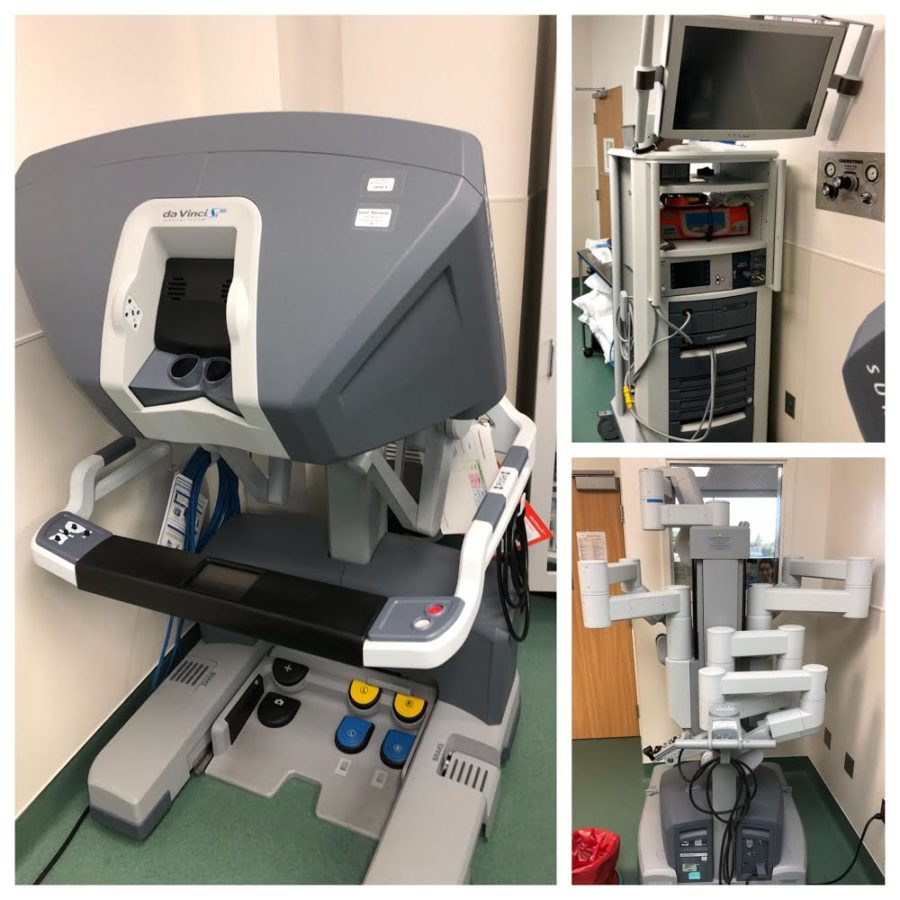Smart Healthcare: Technology Advances In Healthcare
The Da Vinci machine is one of the many advancements in healthcare.
August 20, 2018
WELCOME TO THE AGE OF TECHNOLOGY.
The burst of technological advancements around us is sometimes overwhelming. Whether it be for entertainment, learning, transportation and more, new technology is skyrocketing. Smart technology is even geared towards health care. Even hospitals are finding new ways to improve patient treatment using smart technology. I was incredibly interested in two pieces of equipment currently being used in some hospitals: the TeleHealth and the da Vinci Robotic Surgical Machine. I visited St. Mary’s Hospital in Apple Valley to see these new innovations and interviewed some health care professionals who work with these types of equipment. I had the privilege of meeting Nicholas Long, an Emergency Room (ER) Charge Nurse, Sharna Dobbins, an Operating Room (OR) Circulator Charge Nurse and Dr. William Rivera (Surgeon).
Telehealth is one of the many tools that healthcare providers, like neurologists and psychiatrists, use for easy accessibility to patients wherever they happen to be. If they are stuck in traffic or someplace else where they cannot reach a patient immediately, a Telehealth comes in handy. Let’s play this scenario: Your elderly neighbor suddenly has a droopy face, cannot move her entire right side and was brought to the ER. She is told she may be having a stroke. According to MayoClinic.org, a stroke “occurs when the blood supply of the brain is interrupted or reduced.” Apparently, your neighbor has a portion of her brain receiving little to no blood supply, which is causing all of her symptoms. Time is gold. There is great urgency for these types of patients to be immediately seen and treated. If a neurologist is needed to evaluate a patient, the ER nurse may wheel in the Telestroke. It’s like Facetime, but on a bigger screen and with a very important purpose – having a neurologist evaluate that patient ASAP!
“A neurologist comes online, kind of like on Skype – they have audio and video. They can do their assessments, remotely from their home and/or their office,” said RN Nicholas Long.
The da Vinci Surgical Machine is another cool robotic ‘tool’ out there. I wish I could have had the chance to play around with it as if this were an Apple store, but only surgeons with actual patients are allowed to do so. It doesn’t operate by itself but is robot-assisted which allows a surgeon to operate it while he is sitting at a console. There are robotic arms that a surgeon can control, kind of like playing a video game.
“In this case, the surgeon isn’t really hands-on; it’s a robot with arms and [the surgeon] works a joystick [which] moves the arms during the surgery,” Sharna Dobbins RN said.
Patients do not have to wait longer for their surgery, but it is still very pricey. “Sometimes the traditional laparoscopic surgery is better than the robotic surgery. Plus you need extra crew members to work the robot versus if you did laparoscopic surgery,” said Dobbins. But she also claimed most surgeons might find it a lot easier using the robot to get the job done. “It depends on the surgeon that’s working,” said Dobbins.
There are numerous other types of advanced medical equipment that are being used in the health profession. Similar to the da Vinci, another surgical robot is called ‘Octopus-Inspired Robotic Arms’. As stated on LiveScience.com, “it could make it easier for surgeons to access hard-to-reach parts of the body.” Its name sounds like something from a sci-fi movie, doesn’t it? Moreover, there are such robots that can draw patients’ blood, disinfect germs in the hospital environment and exoskeleton devices that may be used to help paralyzed people relearn how to walk.
Medical technology still has a lot of room to grow. More new innovations in healthcare are still being created, especially by big cutting-edge companies such as IBM (Watson), Google (Deep Minds) and Intuitive (Future Innovation).
With the surge of cool medical gadgets and robotic equipment, where is the future of healthcare heading? It’d be no surprise if there are technologies far more advanced that emerge in the near future. Artificial Intelligence may be coming next.
“Smart Healthcare [A.I. medical advancements], isn’t quite there yet. But that’s where it is leaning,” said Dr. William Rivera.
It may take awhile to accept A.I. in our society, for some like me who fear that it may eventually replace humankind. It might sound too extreme. Perhaps I just watch too much sci-fi movies.
“I think it will be used to augment people but not to replace people, I think it’s perfectly fine,” said Nicholas Long.






